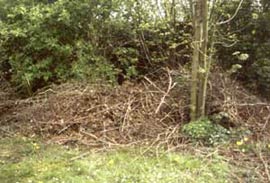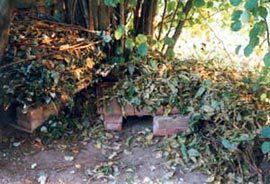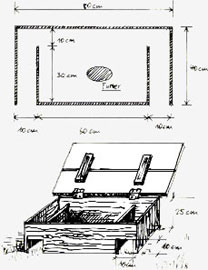Originally hedgehogs must have lived in woods with a diversity of natural cover which offered both shelter and prey items. They then adapted to changes in the countryside caused by human intervention.
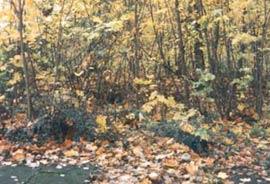
During the summer hedgehogs occupy several, often not very carefully made, nests which they do not use for any length of time. Sometimes they just rest in long grass during the day.
Breeding nests are of more durable construction for the mother to rear her young. Winter nests must be well insulated and waterproof to keep out rain and snow. Hedgehogs build their winter nests mostly with leaves and so that they do not fall apart, they usually site them under supporting vegetation, under hedges, under ground cover plants, and also in hollow spaces under garages, sheds or in log piles.
Hedgehogs are prey to eagle owls, foxes and badgers. Dogs can kill adult hedgehogs and cats can kill hoglets. This predation does not threaten the survival of the species. The hedgehog’s biggest enemy is man because of the many ways he interferes with nature.
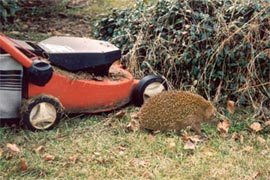
In their retreats- residential areas with gardens, parks and “green” outskirts – hedgehogs are subject to a great variety of hazards such as strimmers, mowers, garden forks, steep sided pits, manholes, swimming pools, traps, poisoned baits, garden netting, and bonfires. Pesticides and artificial fertilizers annihilate natural food sources. Nest sites are destroyed by manic garden tidying.
In Germany more than 500000 hedgehogs get run over by cars each year, countless orphans die painfully. Agrarian wastelands and monoculture provide neither food nor shelter, areas of natural habitat are often not linked to each other.
Look at the environment through a hedgehog’s eyes, read more about Dangers.
In some European countries the hedgehog is listed in the Red Data Book of endangered species. In Germany it is protected by the Bundesnaturschutzgesetz (Federal wildlife conservation law) throughout the year.
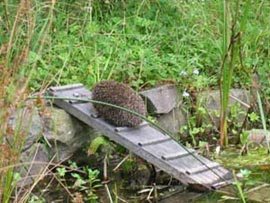
If you provide food early enough in spring and autumn it may not be necessary to take underweight hedgehogs into care. Feed tinned cat food mixed with dry hedgehog food or porridge oats and/or unseasoned scrambled egg.
To keep birds – and rain – away from the food, cover it with a wooden box with at least two 10 x10 cm entrance holes cut in the sides.
To protect the food from unwelcome guests, a cat proof feeding house can be built with a crooked entrance (see illustration). Remove remaining food in the morning and wash the dishes in hot water.
Having a natural garden is the best help you can give to hedgehogs. You can also provide artificial shelters for day nesting and for hibernation. Hedgehog houses can be home made or bought from pet shops, garden centres, some workshops and also from many regional hedgehog rescue societies. Read more about Hedgehog houses.




